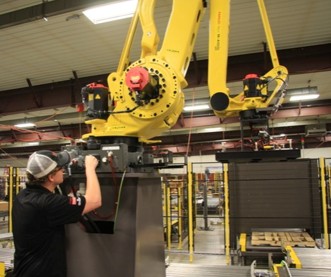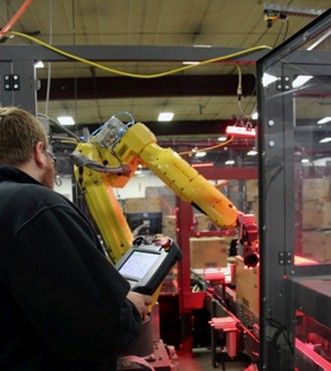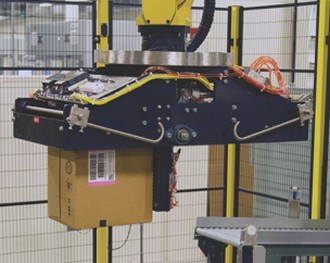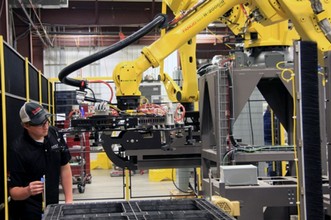Robotic case loading or palletizing can provide worry-free high uptime on the packaging line when the maintenance team takes three basic steps.
By Bret Riedel, Service Technician, Brenton Engineering
Robots are one of the most reliable machines on the packaging line. In fact, they require far less preventive maintenance than most pieces of equipment in the plant. When robots are the core of a case loading or palletizing system the maintenance requirements become a little more complex than simply focusing on the robotic arm. By following three basic steps, the in-house maintenance team can ensure maximum uptime and optimum throughput for the packaging system.
Step 1: Make sure that preventive maintenance intervals are strictly followed and that the packaging systems supplier, robot manufacturer, or highly trained and competent in-house maintenance person carries out the service
 Robots are exceptionally well designed and rugged machines. They don’t need to be greased or have their batteries changed for periods stretching into years. The problem is that if an in-house maintenance team only works on a robot once every two to three years, it is like starting over each time. Memory of proper procedures fade. If someone forgets the key steps to correctly grease a robot, replace its batteries, or perform some other task, there can be, and often is, a cascading series of errors that may lead to thousands of dollars in emergency repairs and an equal or higher cost for manual labor to pick up the slack on the packaging line.
Robots are exceptionally well designed and rugged machines. They don’t need to be greased or have their batteries changed for periods stretching into years. The problem is that if an in-house maintenance team only works on a robot once every two to three years, it is like starting over each time. Memory of proper procedures fade. If someone forgets the key steps to correctly grease a robot, replace its batteries, or perform some other task, there can be, and often is, a cascading series of errors that may lead to thousands of dollars in emergency repairs and an equal or higher cost for manual labor to pick up the slack on the packaging line.
Large corporations with numerous robotic systems usually have a few people that specialize in preventive maintenance for robots. Not so for the small to midsized operations that may have one or only a few robots. For these companies, Step 1 in maintaining uptime is to engage the packaging system’s supplier or a factory authorized technician for periodic preventive maintenance. The expense of paying for an outside technician will be outweighed by the ongoing productivity of the packaging system. Furthermore, when an outside service technician comes into the plant, he or she can incorporate any modifications or upgrades that are needed since the last visit and will answer questions the in-house maintenance team may have on system operation.
Step 2: Make a point of having annual troubleshooting training for the maintenance team
 While it may be years between service intervals, troubleshooting an operational problem or programming the robot to accommodate a new shipping case size occurs much more frequently. Annual refresher training on using the robotic system’s HMI and teach pendant to assist in solving problems is a valuable use of the maintenance team’s time and will directly contribute to improved productivity. As experienced technicians cycle off the maintenance team for other duties and new men and women take their place, training achieves a new level of significance.
While it may be years between service intervals, troubleshooting an operational problem or programming the robot to accommodate a new shipping case size occurs much more frequently. Annual refresher training on using the robotic system’s HMI and teach pendant to assist in solving problems is a valuable use of the maintenance team’s time and will directly contribute to improved productivity. As experienced technicians cycle off the maintenance team for other duties and new men and women take their place, training achieves a new level of significance.
Refresher training can be customized for the needs of the team. Most commonly the core of the refresher involves:
- Manually jogging the robot in WORLD and JOINT modes using the teach pendant
- Utilizing the alarm menu to quickly and effectively diagnose problems
- Moving through the I/O screens on the HMI to troubleshoot faults
In cases where a new pack pattern or new shipping case is adopted, having familiarity with the teach pendant’s setup menus saves time and reduces headaches. The same logic holds true for alarm menus and I/O screens – refreshers put problem solving power into the hands of maintenance personnel. Having a trainer on site annually gives the in-house team the opportunity to become more proficient through question and instruction.
 It is important to keep in mind for the refresher training and for daily awareness that as much as 90 percent of the problems experienced with a packaging system can be traced back to an issue with I/O. These systems experience a lot of vibration and are subject to rough handling, which causes wear on I/O devices.
It is important to keep in mind for the refresher training and for daily awareness that as much as 90 percent of the problems experienced with a packaging system can be traced back to an issue with I/O. These systems experience a lot of vibration and are subject to rough handling, which causes wear on I/O devices.
Step 3: Become a packaging system detective by gaining knowledge of the key inputs – materials, conveyors, pallets, photo eyes, and more
Robots thrive on repeatability. They have problems with variation. As long as the system feeding the robot is within specification, case packing or palletizing is flawless. When inputs to the system exceed expected tolerances, productivity goes down. People tend to point a finger at the robot as the cause of a problem in a packaging system. Most of the time the real issue can be traced to a faulty input in material, conveyor, pallet, or I/O device.
For example, a service technician was called to a plant because as layers of shipping cases were stacked the top few layers had a pronounced tilt. The outside technician determined he could fix the problem by reprogramming the palletizing pattern but instead decided to address the root cause of the issue. It was discovered that the case sealer was applying tape in such a way that the shipping cases were somewhat deformed. The out of square issue built up layer by layer until the top layers were tilted. The case sealer was readjusted and the problem was solved.
 One customer was having a terrible time with the end-of-arm tool dropping cases. Nothing the customer tried could fix the problem and an outside service technician was called. The problem turned out to be porous corrugated board in a shipment of boxes from a new box supplier. It was as if the robot were trying to pick up a screen door with a suction cup. A fresh supply of boxes solved that problem. Another customer complained that the system was inconsistently handling pallets. This is a rather common problem often caused by warped, broken, non-standard, and otherwise damaged pallets that are still being flowed through in a highly precise system.
One customer was having a terrible time with the end-of-arm tool dropping cases. Nothing the customer tried could fix the problem and an outside service technician was called. The problem turned out to be porous corrugated board in a shipment of boxes from a new box supplier. It was as if the robot were trying to pick up a screen door with a suction cup. A fresh supply of boxes solved that problem. Another customer complained that the system was inconsistently handling pallets. This is a rather common problem often caused by warped, broken, non-standard, and otherwise damaged pallets that are still being flowed through in a highly precise system.
The point of these three examples is to highlight the impact of inputs on palletizing uptime. In all three examples the robot was programmed to expect consistent inputs. It did not receive those and issues emerged. It takes a palletizing system detective to shift through the clues and find the culprit.
There are other areas that typically need to be watched carefully:
- End-of-arm tooling with its air lines, vacuum lines, and wiring present the single highest area of wear on the robot. Even with the best quality tubing and wiring, the constant flexing causes problems. The maintenance team should pay close and frequent attention to the end-of-arm tooling to secure lines and wiring and replace worn parts promptly.
- Photo eyes tend to get bumped or dirty and loosen up over time. Be aware of this.
Conveyors need to be maintained in order to deliver cases at a specified rate.
 Having highlighted the most common issues with robots, it must be restated that they are one of the most reliable machines on the packaging line. Brenton Engineering has installed systems that have operated flawlessly for 10 or more years before the customer required a service technician. The three steps outlined here to ensure smooth operations are not expensive or time consuming to implement and can have a profoundly positive impact on assured throughput and uptime.
Having highlighted the most common issues with robots, it must be restated that they are one of the most reliable machines on the packaging line. Brenton Engineering has installed systems that have operated flawlessly for 10 or more years before the customer required a service technician. The three steps outlined here to ensure smooth operations are not expensive or time consuming to implement and can have a profoundly positive impact on assured throughput and uptime.
